Improved Optoelectronic Characteristics of Ga-In co-Doped ZnO UV Photodetectors by Asymmetric Metal Contact Structure
Abstract
:1. Introduction
2. Materials and Methods
3. Results and Discussion
3.1. Characteristics of Sol-Gel Derived ZnO:Ga-In Thin Films
3.2. Performance of the ZnO:Ga-In UV Photodetectors
4. Conclusions
Author Contributions
Funding
Institutional Review Board Statement
Informed Consent Statement
Data Availability Statement
Acknowledgments
Conflicts of Interest
References
- Borysiewicz, M.A. ZnO as a functional material, a review. Crystals 2019, 9, 505. [Google Scholar] [CrossRef] [Green Version]
- Radzimska, A.K.; Jessionowski, T. Zinc oxide-from synthesis to application: A review. Materials 2014, 7, 2833–2881. [Google Scholar] [CrossRef] [PubMed] [Green Version]
- Özgür, Ü.; Hofstetter, D.; Morkoc, H. ZnO devices and applications: A review of current status and future prospects. Proc. IEEE 2010, 98, 1255–1268. [Google Scholar] [CrossRef]
- Shohany, B.G.; Zak, A.K. Doped ZnO nanostructures with selected elements-structural, morphology and optical properties: A review. Ceram. Int. 2020, 45, 5507–5520. [Google Scholar] [CrossRef]
- Tsay, C.Y.; Lee, W.C. Effect of dopants on the structural, optical and electrical properties of sol–gel derived ZnO semiconductor thin films. Curr. Appl. Phys. 2013, 13, 60–65. [Google Scholar] [CrossRef]
- Potter, D.B.; Powell, M.J.; Parkin, I.P.; Carmalt, C.J. Aluminium/gallium, indium/gallium, and aluminium/indium co-doped ZnO thin films deposited viaaerosol assisted CVD. J. Mater. Chem. C 2018, 6, 588–597. [Google Scholar] [CrossRef] [Green Version]
- Lim, J.H.; Lee, S.M.; Kim, H.S.; Kim, H.Y.; Park, J.; Jung, S.B.; Park, G.C.; Kim, J.; Joo, J. Synergistic effect of Indium and Gallium co-doping on growth behavior and physical properties of hydrothermally grown ZnO nanorods. Sci. Rep. 2017, 7, 41992. [Google Scholar] [CrossRef] [Green Version]
- Shaheera, M.; Girija, K.G.; Kaur, M.; Geetha, V.; Debnath, A.K.; Vatsa, R.K.; Muthe, K.P.; Gadkari, S.C. Elucidation of structural, morphological, optical and photoluminescence properties of single and (In, Ga) co-doped ZnO nanocrystalline thin films. Bull. Mater. Sci. 2019, 42, 266. [Google Scholar] [CrossRef] [Green Version]
- Li, H.; Schirra, L.K.; Shim, J.; Cheun, H.; Kippelen, B.; Monti, O.L.A.; Bredas, J.L. Zinc oxide as a model transparent conducting oxide: A Theoretical and Experimental Study of the Impact of Hydroxylation, Vacancies, Interstitials, and Extrinsic Doping on the Electronic Properties of the Polar ZnO (0002) Surface. Chem. Mat. 2012, 24, 3044–3055. [Google Scholar] [CrossRef]
- Vorobyeva, N.A.; Rumyantseva, M.N.; Vasiliev, R.B.; Kozlovskiy, V.F.; Soshnikova, Y.M.; Filatova, D.G.; Zaytsev, V.B.; Zaytseva, A.V.; Gaskov, A.M. Doping effects on electrical and optical properties of spin-coated ZnO thin films. Vacuum 2015, 114, 198–204. [Google Scholar] [CrossRef]
- Kang, J.; Jo, G.; Ji, J.H.; Koh, J.H. Improved electrical properties of laser annealed In and Ga co-doped ZnO thin films for transparent conducting oxide applications. Ceram. Int. 2019, 45, 23934–23940. [Google Scholar] [CrossRef]
- Sang, L.; Liao, M.; Sumiya, M. A comprehensive review of semiconductor ultraviolet photodetectors: From thin film to one-dimensional nanostructures. Sensors 2013, 13, 10482–10518. [Google Scholar] [CrossRef] [PubMed]
- Alaie, Z.; Nejad, S.M.; Yousefi, M.H. Recent advances in ultraviolet photodetectors. Mater. Sci. Semicond. Process. 2015, 29, 16–55. [Google Scholar] [CrossRef]
- Tao, J.; Xiao, Z.; Wang, J.; Li, C.; Sun, X.; Li, F.; Zou, X.; Liao, G.; Zou, Z. A self-powered, flexible photodetector based on perovskite nanowires with Ni-Al electrodes. J. Alloys Compd. 2020, 845, 155311. [Google Scholar] [CrossRef]
- Boruah, B.D. Zinc oxide ultraviolet photodetectors: Rapid progress from conventional to self-powered photodetectors. Nanoscale Adv. 2019, 1, 2059–2085. [Google Scholar] [CrossRef] [Green Version]
- Tsay, C.Y.; Hsiao, I.P.; Chang, F.Y.; Hsu, C.L. Improving the photoelectrical characteristics of self-powered p-GaN film/n-ZnO nanowires heterojunction ultraviolet photodetectors through gallium and indium co-doping. Mater. Sci. Semicond. Process. 2021, 121, 105295. [Google Scholar] [CrossRef]
- Chen, H.Y.; Liu, K.W.; Chen, X.; Zhang, Z.Z.; Fan, M.M.; Jiang, M.M.; Xie, X.H.; Zhao, H.F.; Shen, D.Z. Realization of a self-powered ZnO MSM UV photodetector with high responsivity using an asymmetric pair of Au electrodes. J. Mater. Chem. C 2014, 2, 9689–9694. [Google Scholar] [CrossRef]
- An, Y.; Liao, J.; Wu, C.; Zhang, R.; Li, Y.; Li, T. GaN MSM UV detectors with different electrode materials. J. Electron Devices Soc. 2021, 9, 1210–1214. [Google Scholar] [CrossRef]
- Casalino, M.; Iodice, M.; Sirleto, L.; Rendinam, I.; Coppola, G. Asymmetric MSM sub-bandgap all-silicon photodetector with low dark current. Opt. Express 2013, 21, 28072. [Google Scholar] [CrossRef]
- Ghodsi, F.E.; Absalan, H. Comparative study of ZnO thin films prepared by different sol-gel route. Acta Phys. Pol. A 2010, 118, 659–664. [Google Scholar] [CrossRef]
- Tsay, C.Y.; Yu, S.H. Melioration of electrical and optical properties of Al and B co-doped ZnO transparent semiconductor thin films. Coatings 2021, 11, 1259. [Google Scholar] [CrossRef]
- Cullity, B.D.; Stock, S.R. Elements of X-ray Diffraction, 3rd ed.; Prentice Hall: New Jersey, NY, USA, 2001; p. 170. ISBN 0-201-61091-4. [Google Scholar]
- Kim, Y.S.; Tai, W.P. Electrical and optical properties of Al-doped ZnO thin films by sol-gel process. Appl. Surf. Sci. 2007, 253, 4911–4916. [Google Scholar] [CrossRef]
- Park, G.C.; Hwang, S.M.; Lee, S.M.; Choi, J.H.; Song, K.M.; Kim, H.Y.; Kim, H.S.; Eum, S.J.; Jung, S.B.; Lim, J.H.; et al. Hydrothermally grown In-doped ZnO nanorods on p-GaN films for color-tunable heterojunction light-emitting-diodes. Sci. Rep. 2015, 5, 10410. [Google Scholar] [CrossRef] [PubMed] [Green Version]
- Tauc, J.; Scott, T.A. The optical properties of solids. Phys. Today 1967, 20, 105–107. [Google Scholar] [CrossRef]
- Xu, Q.; Cheng, L.X.; Meng, L.; Wang, Z.; Bai, S.; Tian, X.Q.; Jia, X.F.; Yong, Q. Flexible self-powered ZnO film UV sensor with a high response. ACS Appl. Mater. Interfaces 2019, 11, 26127–26133. [Google Scholar] [CrossRef]
- Jung, U.J.; Kim, S.B.; Kim, D.; Shin, D.S.; Xian, Z.; Park, J. Metal–semiconductor–metal UV detectors using transferrable amorphous and crystalline zinc-tin-oxide microsphere monolayers. ACS Sustain. Chem. Eng. 2020, 8, 60–70. [Google Scholar] [CrossRef]
- Ding, J.; Fang, H.; Lian, Z.; Li, J.; Lv, Q.; Wang, L.; Sun, J.L.; Yan, Q. A self-powered photodetector based on a CH3NH3PbI3 single crystal with asymmetric electrodes. CrystEngComm 2016, 18, 4405–4411. [Google Scholar] [CrossRef]
- Wu, C.Y.; Peng, W.; Fang, T.; Wang, B.; Xie, C.; Wang, L.; Yang, W.H.; Luo, L.B. Asymmetric contact-induced self-driven perovskite-microwire-array photodetectors. Adv. Electron. Mater. 2019, 5, 1900135. [Google Scholar] [CrossRef]
- Rana, A.u.H.S.; Shaikh, S.F.; Al-Enizi, A.M.; Agyeman, D.A.; Ghani, F.; Nah, I.W.; Shahid, A. Intrinsic control in defects density for improved ZnO nanorod-based UV sensor performance. Nanomaterials 2020, 10, 142. [Google Scholar] [CrossRef] [Green Version]
- Humayun, Q.; Kashif, M.; Hashim, U.; Qurashi, A. Selective growth of ZnO nanorods on microgap electrodes and their applications in UV sensors. Nanoscale Res. Lett. 2014, 9, 29. [Google Scholar] [CrossRef] [Green Version]
- Sarwar Rana, A.u.H.; Lee, J.Y.; Hong, Y.P.; Kim, H.S. Transient current response for ZnO nanorod-based doubly transparent UV sensor fabricated on flexible substrate. Phys. Status Solidi—Rapid Res. Lett. 2018, 12, 1800001. [Google Scholar] [CrossRef]
- Nurfani, E.; Kesuma, W.A.P.; Lailani, A.; Anrokhi, M.S.; Kadja, G.T.M.; Rozana, M.; Sipahutar, W.S.; Arif, M.F. Enhanced UV sensing of ZnO films by Cu doping. Opt. Mater. 2021, 114, 110973. [Google Scholar] [CrossRef]
- Tsay, C.Y.; Chen, S.T.; Fan, M.T. Solution-processed Mg-substituted ZnO thin films for metal-semiconductor-metal visible-blind photodetectors. Coatings 2019, 9, 277. [Google Scholar] [CrossRef] [Green Version]
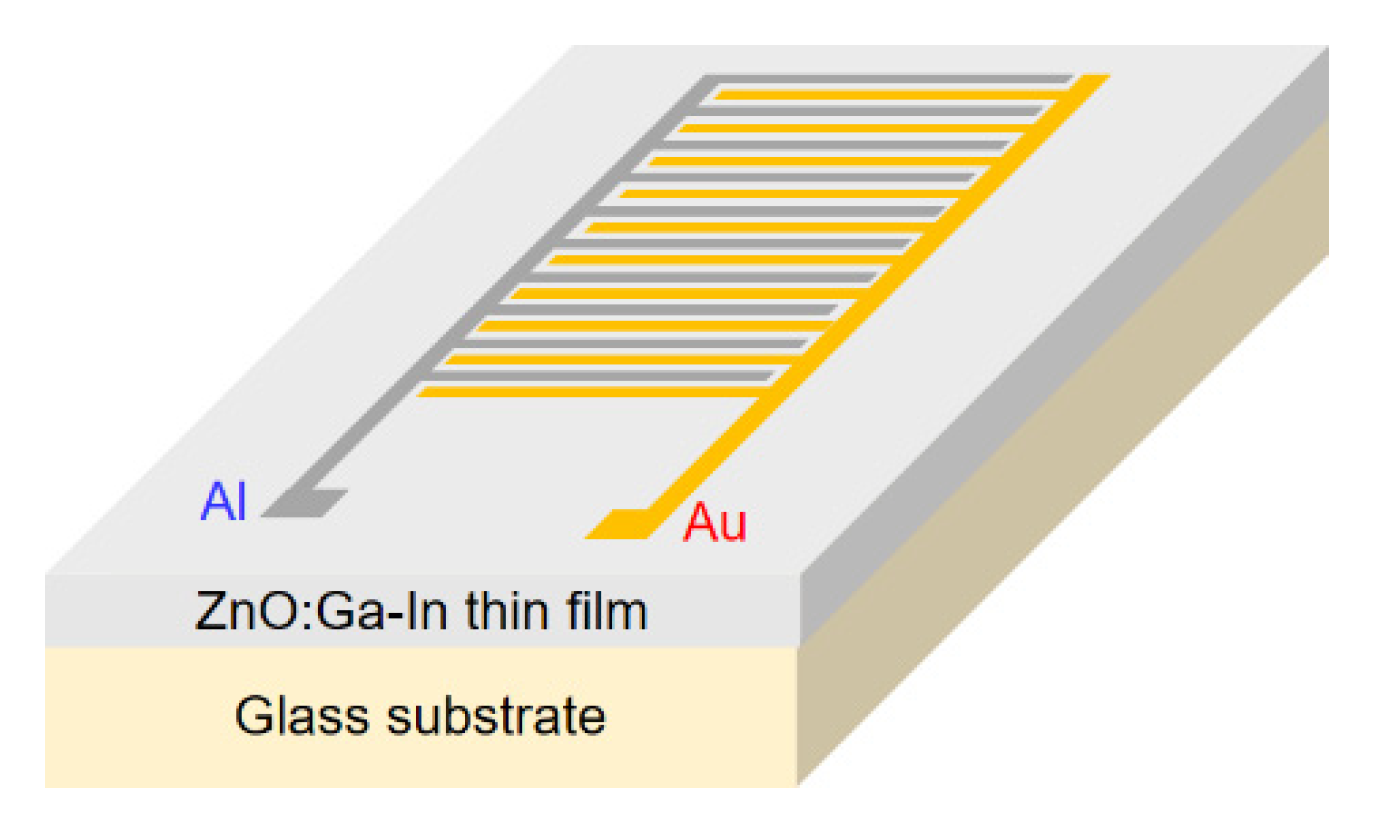
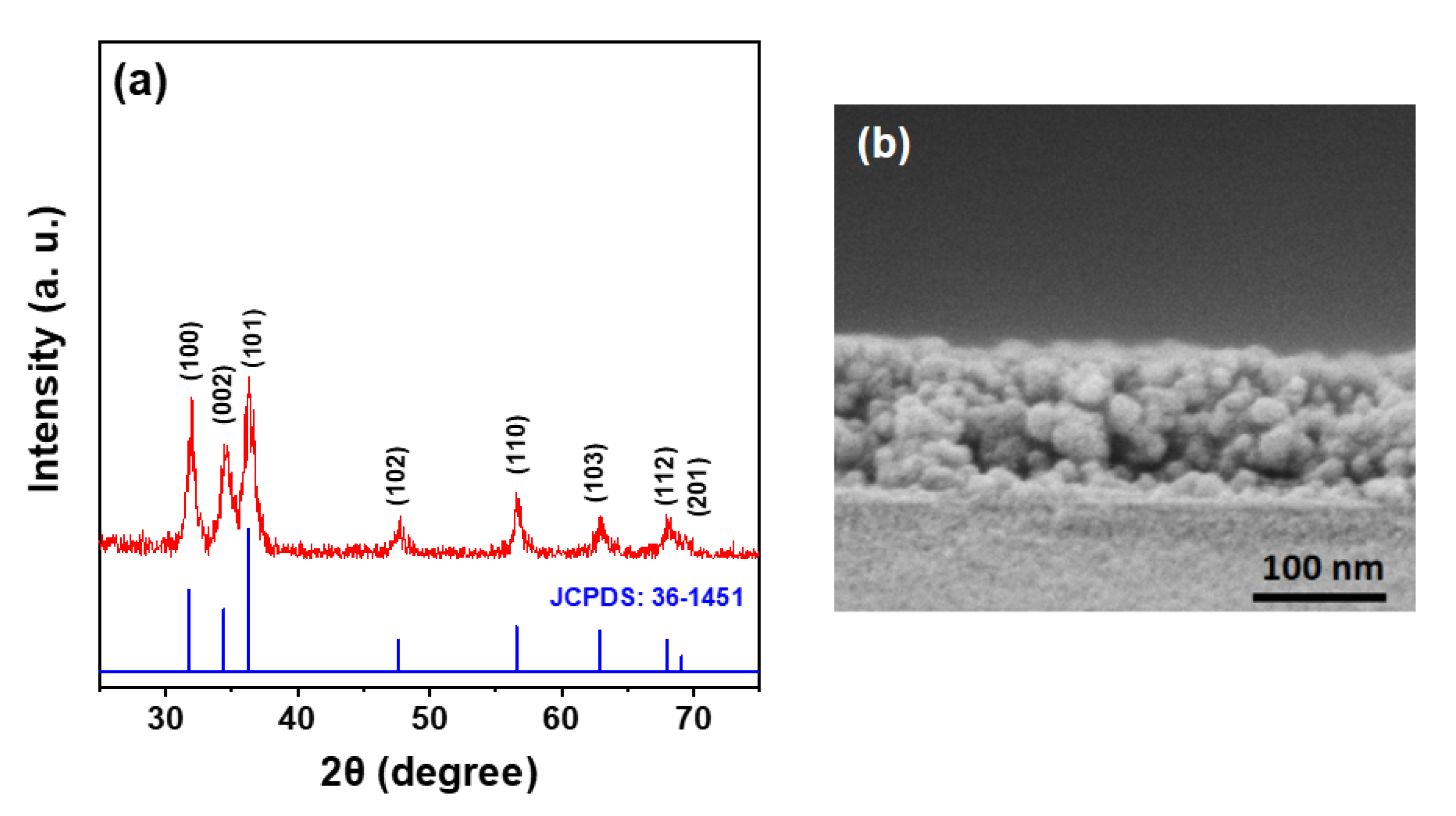
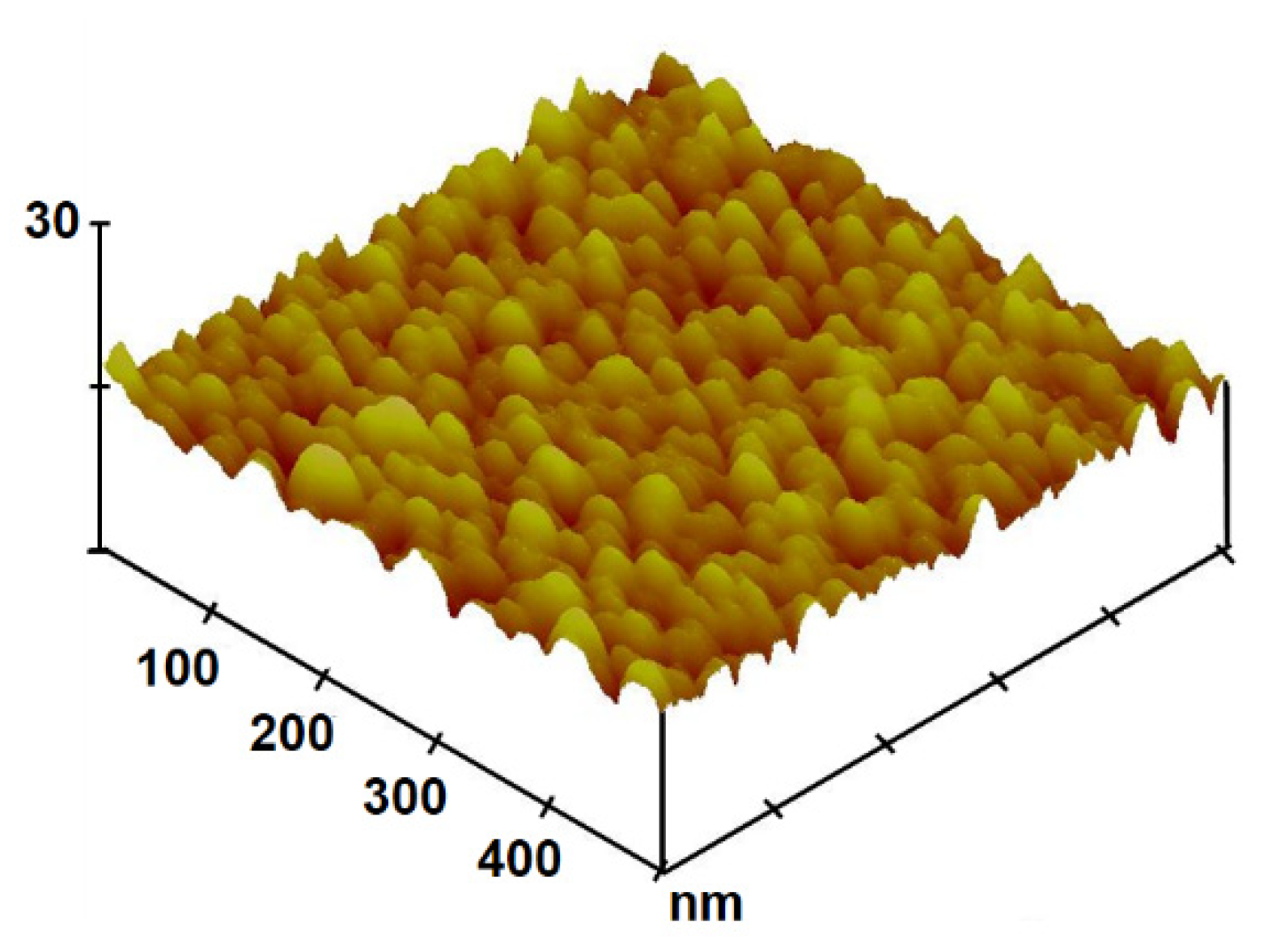
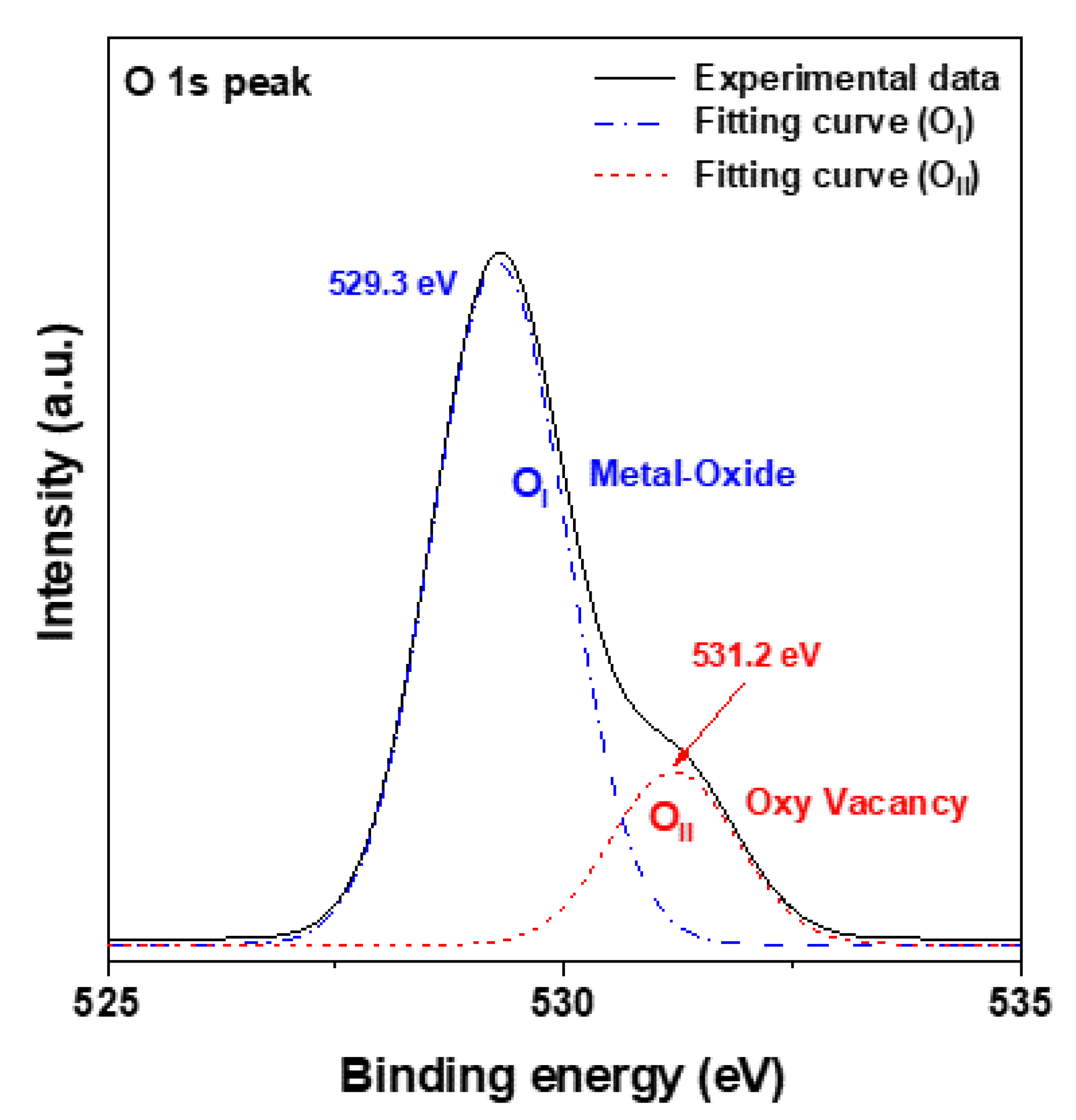
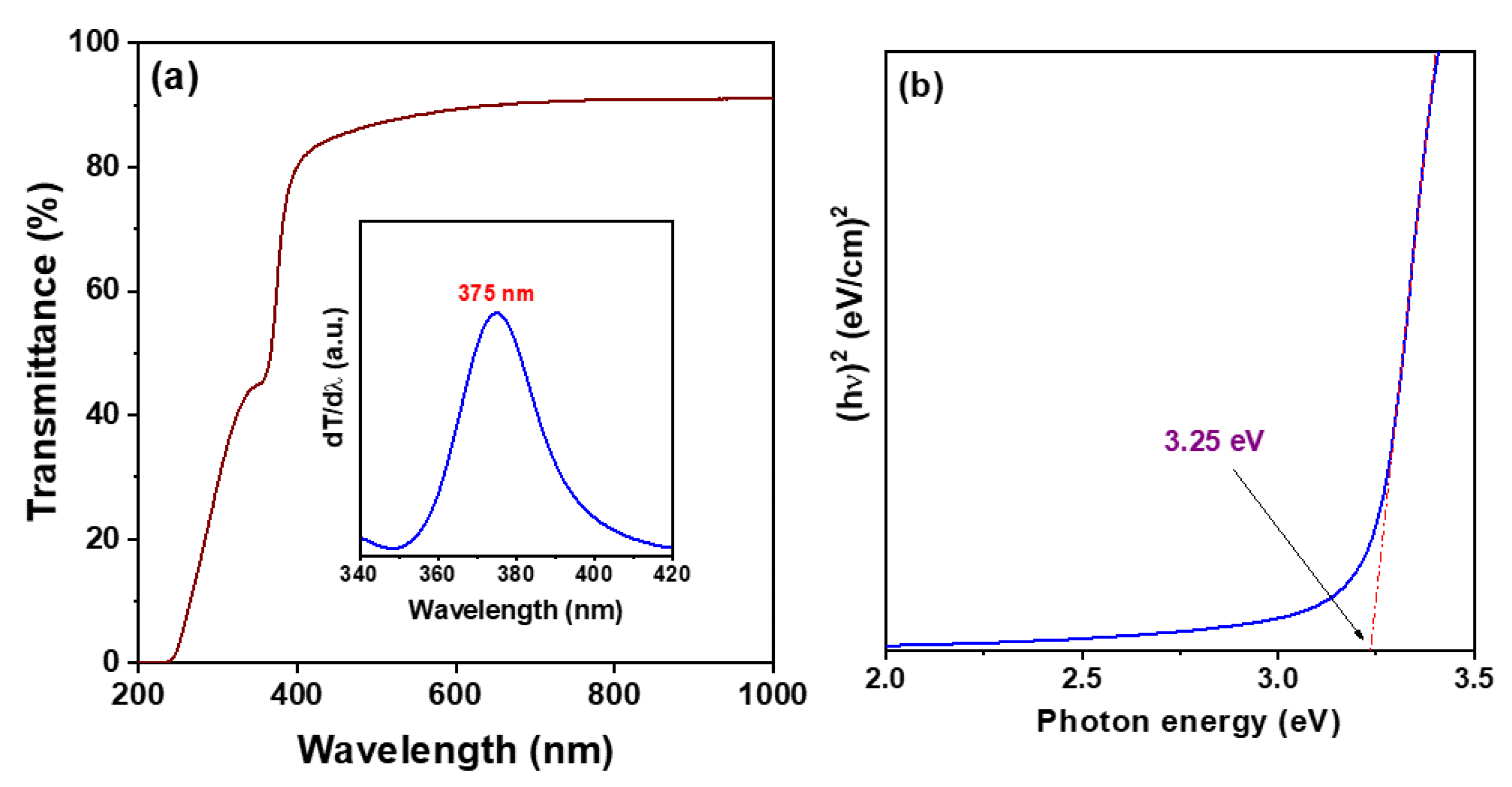
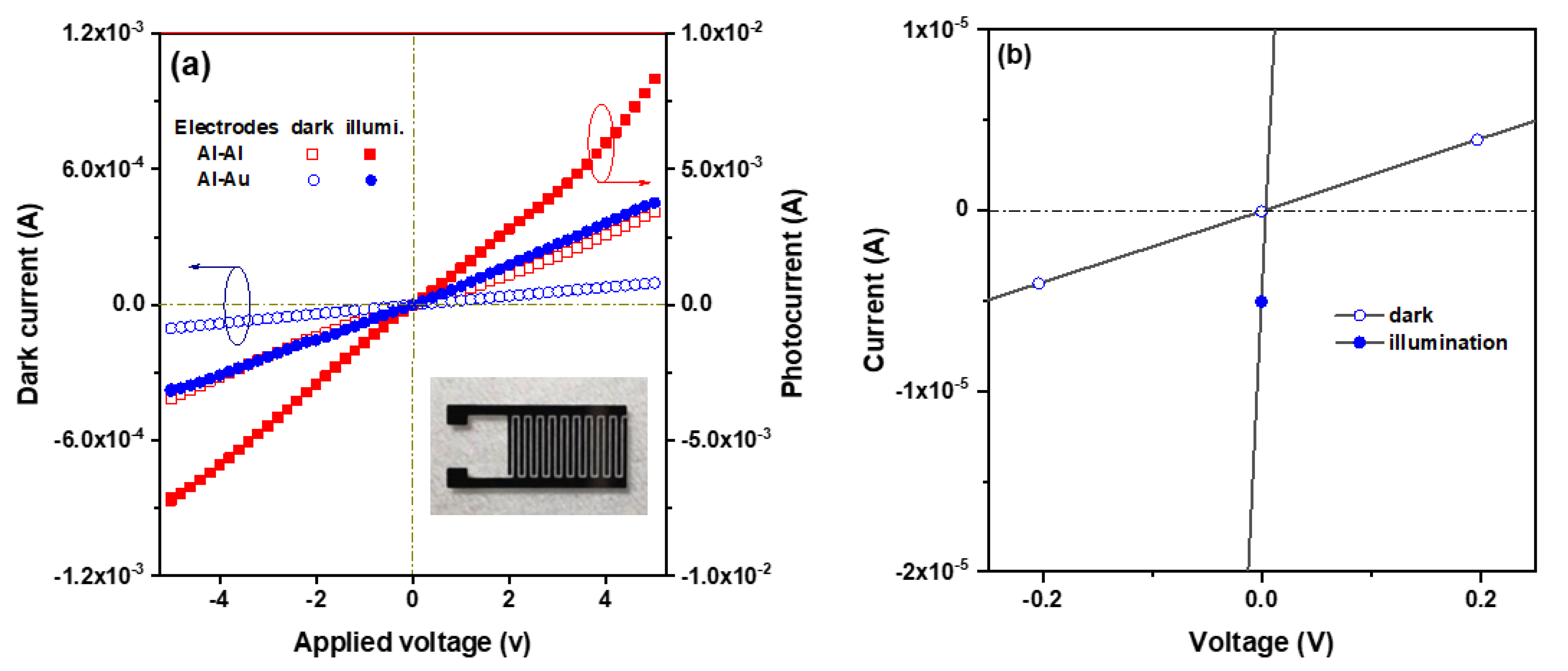
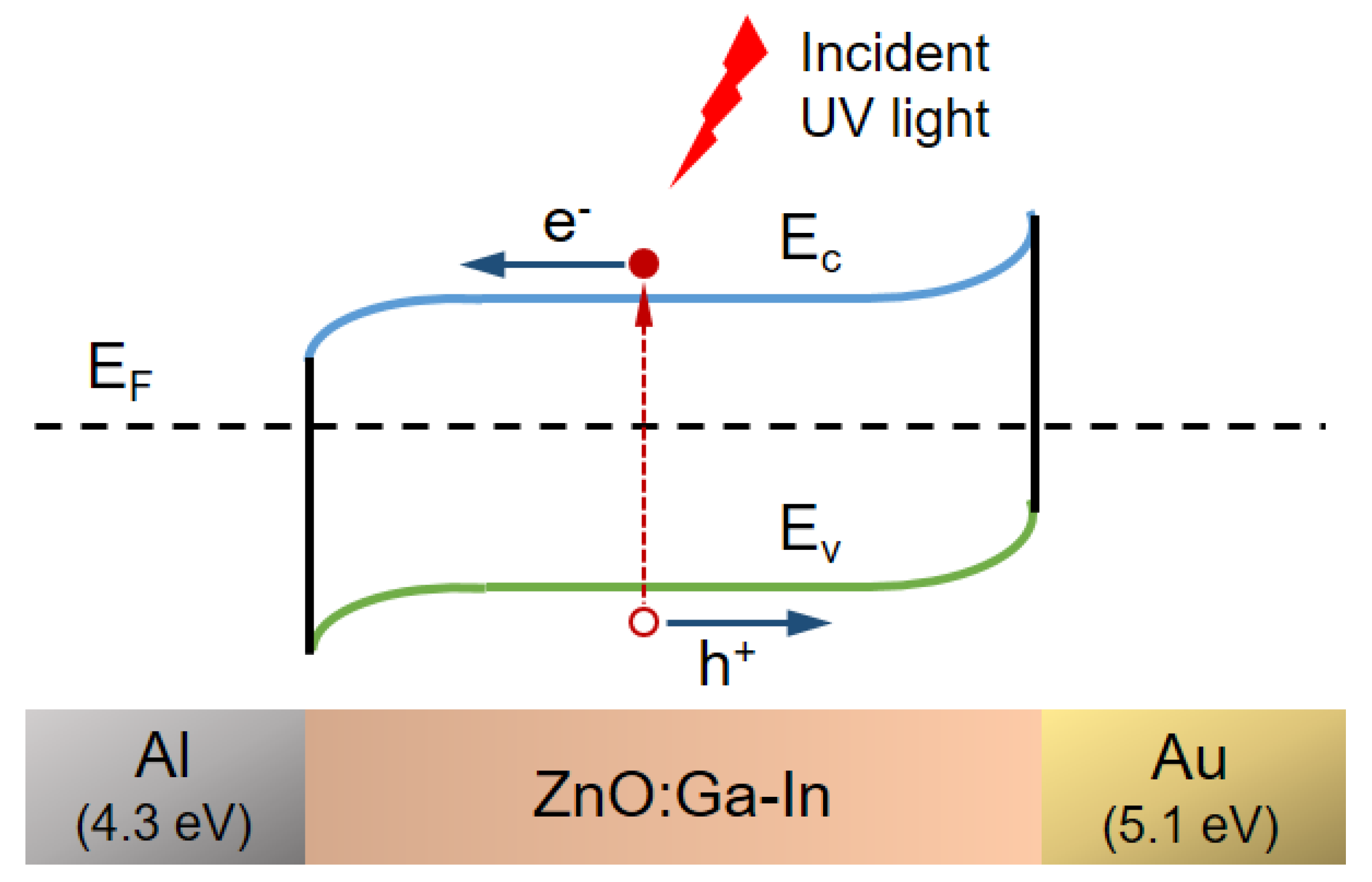
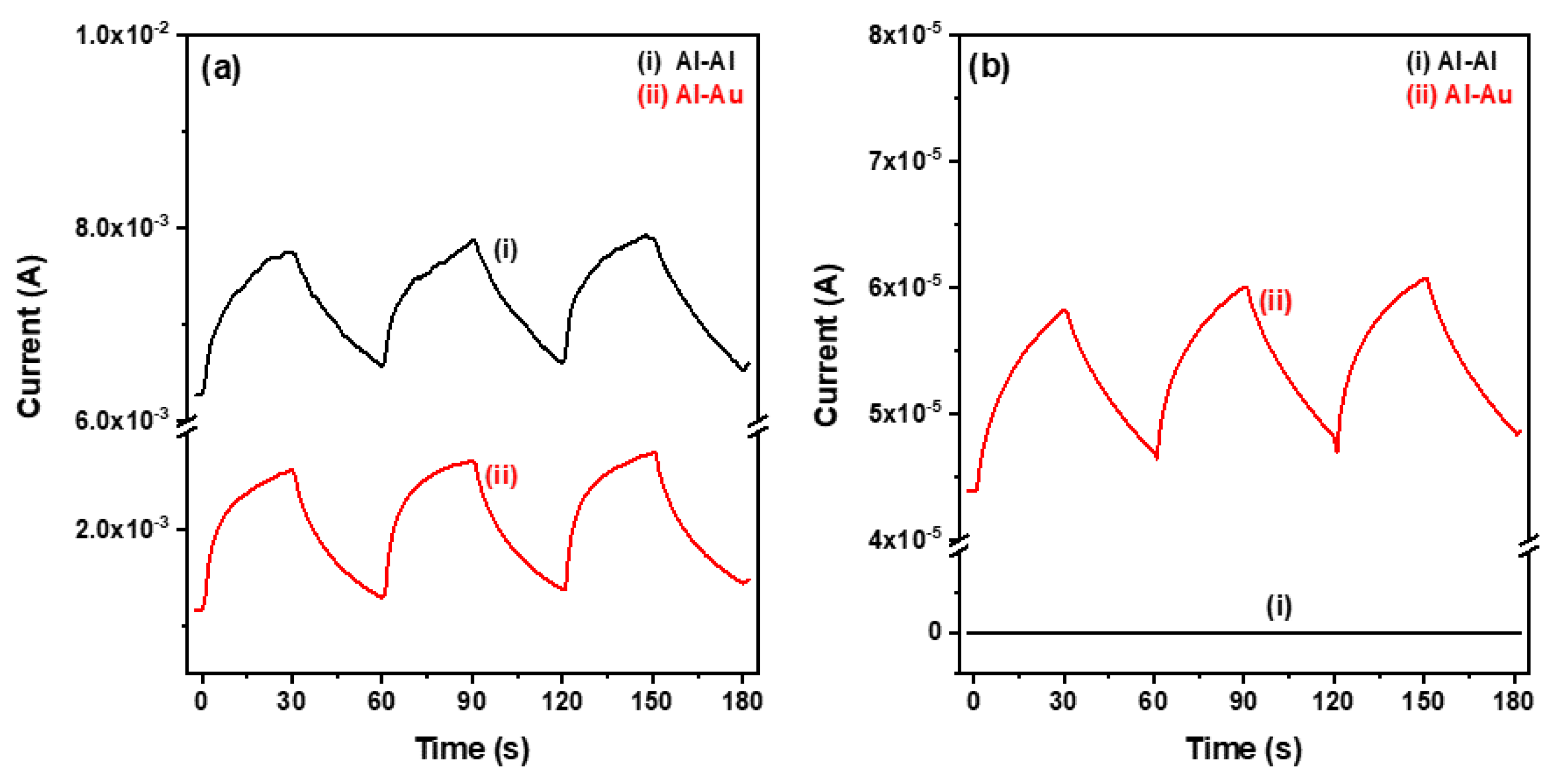
| Device | Bias Voltage (V) | Sensitivity (Iph/Ioff) | Responsivity (mA/W) | External Quantum Efficiency (%) | |
|---|---|---|---|---|---|
| Symmetric electrodes [Al–Al] | 5 | 0.19 | 3.25 | 1089.12 | 2.99 × 107 |
| 0 | --- | --- | --- | --- | |
| Asymmetric electrodes [Al–Au] | 5 | 0.97 | 3.38 | 1132.76 | 6.82 × 107 |
| 0 | 0.25 | 0.03 | 10.05 | 3.25 × 105 |
| Sensing Material | Electrodes/ Substrate | Method/Temperature (°C) | Sensitivity | Responsivity (mA/W) | Illumin. Wavelength | Reference |
|---|---|---|---|---|---|---|
| ZnO:Ga nanorods | Ag–Ag/glass | hydrothermal/90 | --- | 16,000 | 368 nm | [30] |
| ZnO nanorods | Au–Au/Si | hydrothermal/90 | --- | 2000 | 300–370 nm | [31] |
| ZnO nanorods | ITO-ITO/PET | hydrothermal/80 | 0.213 | --- | 365 nm | [32] |
| ZnO:Cu film | Ag–Ag/glass | spray/450 | 25 | --- | 365 nm | [33] |
| Mg0.2Zn0.8O film | Au–Au/glass | sol-gel/500 | 28 | 1.18 | UVA | [34] |
| ZnO:Ga-In film | Al–Au/glass | sol-gel/500 | 0.97 | 3.38 | UVA | This work |
Publisher’s Note: MDPI stays neutral with regard to jurisdictional claims in published maps and institutional affiliations. |
© 2022 by the authors. Licensee MDPI, Basel, Switzerland. This article is an open access article distributed under the terms and conditions of the Creative Commons Attribution (CC BY) license (https://creativecommons.org/licenses/by/4.0/).
Share and Cite
Tsay, C.-Y.; Tsai, H.-M.; Chen, Y.-C. Improved Optoelectronic Characteristics of Ga-In co-Doped ZnO UV Photodetectors by Asymmetric Metal Contact Structure. Crystals 2022, 12, 746. https://doi.org/10.3390/cryst12050746
Tsay C-Y, Tsai H-M, Chen Y-C. Improved Optoelectronic Characteristics of Ga-In co-Doped ZnO UV Photodetectors by Asymmetric Metal Contact Structure. Crystals. 2022; 12(5):746. https://doi.org/10.3390/cryst12050746
Chicago/Turabian StyleTsay, Chien-Yie, Hsuan-Meng Tsai, and Yun-Chi Chen. 2022. "Improved Optoelectronic Characteristics of Ga-In co-Doped ZnO UV Photodetectors by Asymmetric Metal Contact Structure" Crystals 12, no. 5: 746. https://doi.org/10.3390/cryst12050746
APA StyleTsay, C.-Y., Tsai, H.-M., & Chen, Y.-C. (2022). Improved Optoelectronic Characteristics of Ga-In co-Doped ZnO UV Photodetectors by Asymmetric Metal Contact Structure. Crystals, 12(5), 746. https://doi.org/10.3390/cryst12050746






